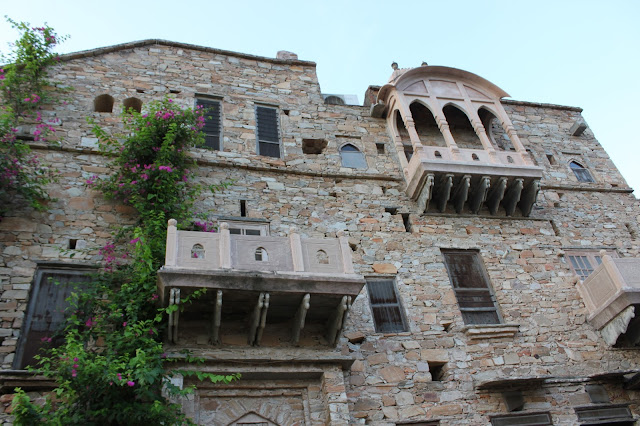Dadhikar Fort - A Modern Day Fable Carved In Stone
 |
| The windows and the balconies at The Dadhikar Fort, are a mix of the Indian and mughal architecture |
In a country which is home to 1.2 billion people, finding serenity is the most luxurious and rare commodity, and this fort, situated 125 km west of India's capital, New Delhi, in the princely state of Rajasthan, is a voyage in a time machine. Leaving behind the swanky glass buildings, the zip-zap zooming, stalled traffic, blaring horns, and the sea of humanity.
The first things that strike you are the laid back pace of life, the greenery, and the dirt track that is shared with herds of buffaloes, cows grazing in the fields, schoolchildren waving gleefully at the lone car passing by - bliss to the nth degree.
Somewhere, a peacock is ready to spread its magnificent wings and welcome the grey clouds gathering in the sky.
This little rocky and rustic fortress is nestled in the valley of the Aravalli mountain range, which is one of the oldest Plateau mountains in India - the fort's yellow sandstones, bathed in the rays of the sun, standing as a jewel in the crown of the nature around it.
This 1,100-year-old footprint of history has risen from the ashes in the late 21st Century. The Dadhikar Fort, was a residential camp of the King of Alwar, in the dense forests that existed that time, was left in ruins after the royal family settled in the city. This fort was forgotten, even wiped from the memories of the people living in that area.
What remained was a hillock with overgrown shrubs and a few remains of what used to be a grand retreat, buried in time.
 |
| Rooftop overlooking the valley of the Aravali mountains surrounding The Dadhikar Fort |
"My family and friends told me that I had lost my sanity," said Kaushik. "Dadhikar was middle of nowhere, there were just a few stones from the old structure, and the foliage covered this hillock."
But, insanity that the bystanders perceived is a state of mind for someone who was going to fit a square peg in a round hole.
The journey began.
Dadhikar was out of a fairy tale, there was neither water nor electricity supply nor was there any road leading here. But, Kaushik said, he had made up his mind, and wanted to restore the fort to its original glory.
He borrowed money from the bank and put his vision to work. There were no plans or drawings of the old fort, much of the work is as a result of Kaushik's sojourns to the ruins and envisaging what the original structure would have looked like.
He trained labourers from the village to work on the project, recycled the stones from rubble, hunted down retired masons who could work with the old style of limestone construction. It was a labour of love.
 |
| A passageway at The Dadhikar Fort |
The Dadhikar Fort, is a confluence of nature, its graceful history, and reflects the ancient Indian art and culture. At the fort, one is transported into back in time no television or radios, no Internet it's life back to where it should be simple, and one with nature.
The hills surrounding this fort have history of their own, there are prehistoric paintings embedded in the rocky crevasses, and the serene pace of life of the village. If India was to be experienced in its pristine glory, The Dadhikar Fort (http://www.dadhikar.in/) is a fine example of that.
 |
| A handmade frame of a bullock cart, which was specially made to be given as a gift to the bride and groom |
For Kaushik, this project is a testimonial of courage, vision, and nothing less than a place of worship.
Mahatma Gandhi once said, A small body of determined spirits fired by an unquenchable faith in their mission can alter the course of history ... Kaushik did exactly that.



Hi Sir,
ReplyDeleteThank you for your wonderful blog and description of our property. Please correct the website address mentioned in your blog. Updated and correct website is http://www.dadhikar.in
Regards,
Sanjay
Dadhikar Fort
email: crm@dadhikar.in
Sanjay, I changed the website address, however the other one is still active and is reflecting as official website for Dadhikar Fort in Google search, you may want to check that.
Delete